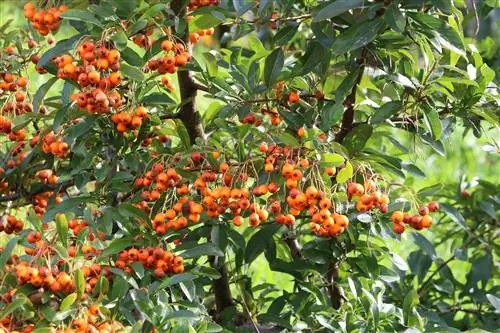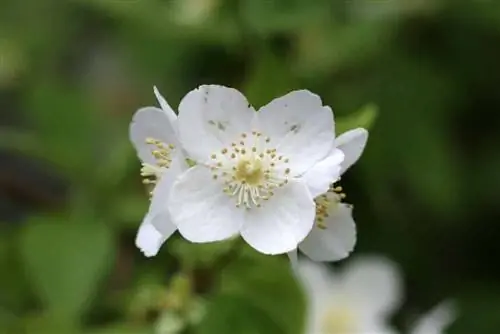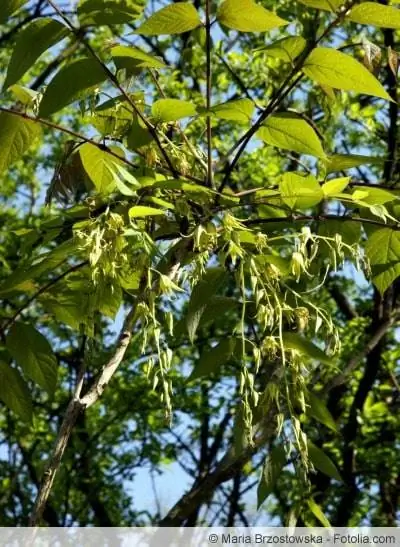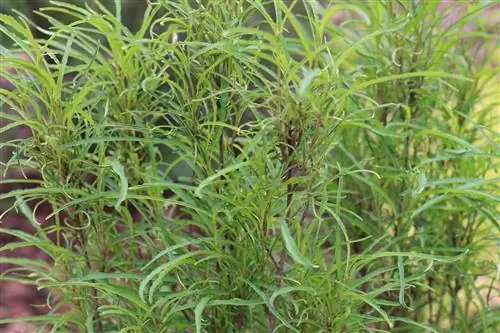- Author admin [email protected].
- Public 2023-12-17 03:39.
- Last modified 2025-01-24 12:45.
The sea buckthorn definitely needs a very sunny place, otherwise the flower and fruit production will decline, but it is completely undemanding when it comes to soil. It is extremely robust and windproof and can even tolerate longer dry periods without any problems. Over the years it becomes several meters high, but doesn't grow particularly quickly.
The first flowers and fruits form about three to four years after the shrub was planted. When planting a sea buckthorn bush, it should be noted that the bush spreads into the garden via root runners. If this is to be prevented, it is best to place a root barrier in the soil when planting. This is a plastic film that is usually sold in garden shops under the name rhizome barrier.
Male and female plants
In order to harvest berries from a sea buckthorn bush, at least one female and one male plant must be planted in the garden. The male plant serves as a pollinator and the berries form on the female plant. If there is plenty of space in the garden, you can plant several female bushes because they are all fertilized by a single male plant. Male and female specimens can be distinguished by their flowers. Female plants form individual flowers, while male plants form several flowers together in clusters.
Growing conditions and harvest
- The sea buckthorn bush is absolutely easy to care for and only needs a little attention during the growing phase, otherwise it gets along well on its own.
- The shrub thrives best on very poor soils and should therefore not be fertilized.
- A sea buckthorn plant blooms with small yellowish flowers in March or April.
- The small, round, orange-red fruits that contain a lot of vitamin C begin to form in August.
Attention: These are quite sour, which is why they are usually not eaten raw, but rather processed. In addition, harvesting them is often quite difficult because of the thorns and the small size of the berries. So that the juice of the sea buckthorn berries is not lost during picking, whole branches with berries can be cut from the bush and placed in a freezer. When frozen, they are easier to remove from the branches.
Cutting sea buckthorn plants
A sea buckthorn bush does not necessarily need to be pruned, but over the years the lower area and the inside of its crown may become bare. Then the shoots should be shortened significantly so that the bush sprouts again. So that the inner area of the crown gets enough light and sun, it should be thinned out a little every now and then. When cutting, however, it should be remembered that sea buckthorn always forms flowers and berries on last year's shoots. Severe pruning therefore means that next year's harvest will be smaller or even completely lost.
Care tips for sea buckthorn
The fact that sea buckthorn is considered easy to care for does not mean that a little care and attention is not required so that the popular plant feels completely comfortable in the home garden. In fact, more and more hobby botanists are choosing sea buckthorn. After all, it not only looks good, but also pampers its “owner” with the valuable vitamins C and B12. Nevertheless, carotene, unsaturated fatty acids and many other valuable active ingredients and ingredients are contained in this popular wild fruit. But be careful: harvesting the fruits can prove to be difficult due to the prickly branches.
If you love sea buckthorn, you should take care of your well-being in this way:
- lots of light, no shadow
- fertilize little or not at all
- lots of free space around the roots
- deep soil
- oxygen-rich soil
- pay attention to the wind conditions
- remove the offshoots regularly (root barrier)
- cut back every two years
Hobby gardeners who not only enjoy the austere beauty of sea buckthorn, but also want to try its fruits every now and then, should have not just one plant in their garden, but at least two females and one male. The latter serves as a quasi “supplier” of the pollen required for pollination. In order to actually generate adequate success in this context, you should also keep an eye on the wind direction when planting sea buckthorn. Ideally, the male plant is positioned to the left of the female bushes, as this way the wind direction can be best utilized with regard to the pollination process.
A desert plant in the home garden
From its origins, the wild fruit plant is used to rather barren, stony soil. A little light sand should be added to clayey soils to equalize the conditions accordingly. It is advisable to fertilize the shrub as rarely as possible, because as a desert plant, sea buckthorn is more used to nutrient-poor conditions. Nevertheless, it doesn't hurt to "give" the plant a few additional nutrients every now and then - about once a year - in order to ensure a "rich harvest".
The fact that the sea buckthorn plant can reach a height of up to four meters and a width of around three meters after a relatively short time is something that the plant lover with the “green thumb” should take into account when choosing a location.
An eye-catcher in the outdoor area
In general, the plant tends to produce numerous offshoots. You can prevent this, for example, by setting a root barrier when planting to prevent “wild growth”. On the other hand, it makes sense to remove the offshoots at regular intervals.






